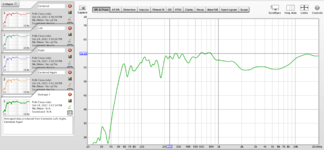janahdfrazier
New member
I've had a pair of Polk Monitor 5A speakers for nearly 10 years, and I've found them to be great listening speakers - detailed highs and nice, fast low end, but suffer from the ubiquitous mid-range "suck" that so many HiFi speakers do. So, I had the idea to analyze their response and boost frequencies above 1k accordingly. I measured the speaker by placing it on a chair in a very dead room (rockwool panels/moving blankets on the ceiling and walls, rug covering the floor) to minimize HF reflections, and placed a Behringer ECM8000 about 16' from the speaker, right in between the midbass and tweeter drivers. I used REW to collect the data. No calibration file for the mic, but I figured it would be good enough for this experiment. Below is the curve before applying EQ.

As I imagined, there was a pretty significant cut between 1k and 10k, with the biggest dips around 2k5 and 5-6k. So, I used a Behringer Ultra-Curve (just a stereo rack EQ) to bring everything beyond 1k up to the 60db mark. A 2.5db increase at 1k, 5.5db increase at 2k, and so on.
So, I put the speakers back in position, and the results were positive. The midrange is more present (obviously), and details in the upper-mids that were previously inaudible can be heard clearly. The Behringer unit has an EQ in/out button that allows you to quickly A/B the speakers with and without EQ, and the difference is significant. The speakers are currently in my mixing position, and I plan to listen and mix on these for a few weeks. Curious to see how this experiment pans out!
I'd love to hear yall's thoughts on this. I don't fully understand the consequence of the phase aberrations that might occur by boosting so much of the spectrum using non-linear EQ, and I don't think that EQ is a substitute for a speaker with a well designed crossover/driver selection. I'd also like to add that there is no LF EQ. The room is treated, and I think most folks know that using EQ to correct room modes is a fool's errand. This was just an attempt to boost the mids and HF of the speaker itself, not in relation to the room it is used in.

As I imagined, there was a pretty significant cut between 1k and 10k, with the biggest dips around 2k5 and 5-6k. So, I used a Behringer Ultra-Curve (just a stereo rack EQ) to bring everything beyond 1k up to the 60db mark. A 2.5db increase at 1k, 5.5db increase at 2k, and so on.
So, I put the speakers back in position, and the results were positive. The midrange is more present (obviously), and details in the upper-mids that were previously inaudible can be heard clearly. The Behringer unit has an EQ in/out button that allows you to quickly A/B the speakers with and without EQ, and the difference is significant. The speakers are currently in my mixing position, and I plan to listen and mix on these for a few weeks. Curious to see how this experiment pans out!
I'd love to hear yall's thoughts on this. I don't fully understand the consequence of the phase aberrations that might occur by boosting so much of the spectrum using non-linear EQ, and I don't think that EQ is a substitute for a speaker with a well designed crossover/driver selection. I'd also like to add that there is no LF EQ. The room is treated, and I think most folks know that using EQ to correct room modes is a fool's errand. This was just an attempt to boost the mids and HF of the speaker itself, not in relation to the room it is used in.
